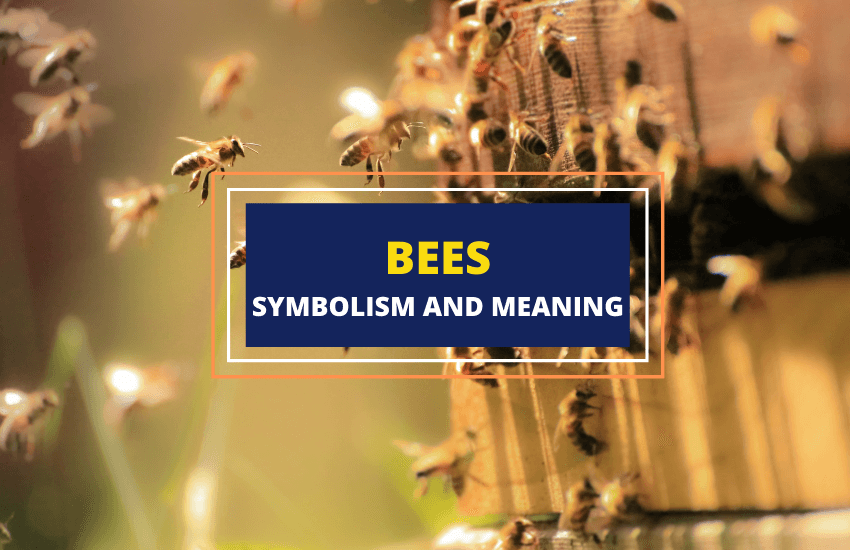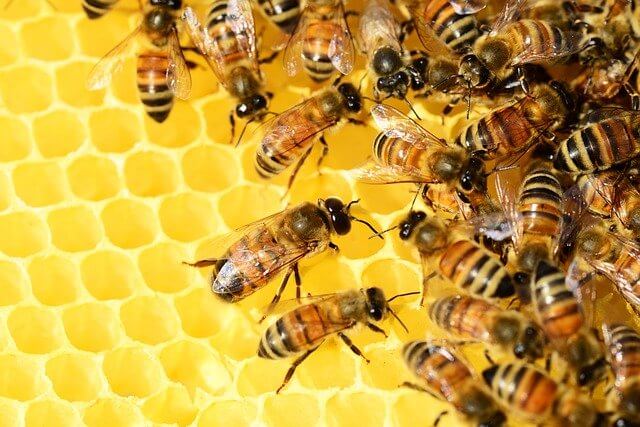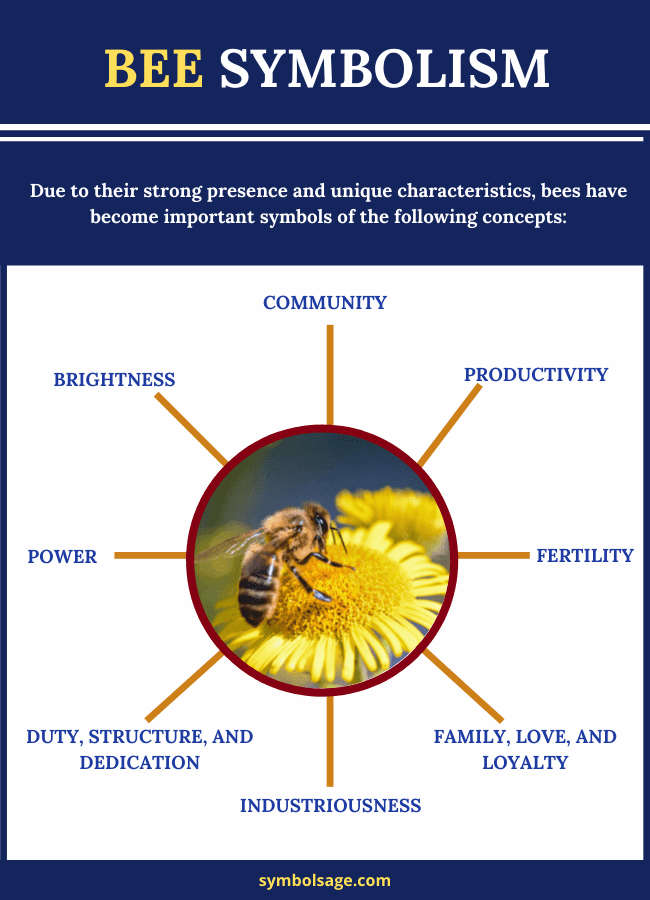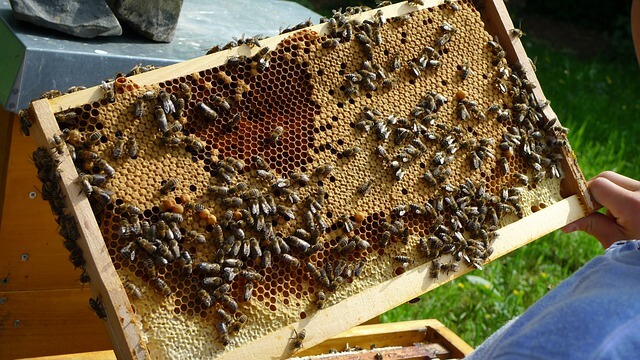
Table of Contents
Did you know that bees are responsible for approximately one-third of the food we eat? Bees might be small insects with a short lifespan, but these very intriguing creatures are highly organized and have a huge impact on the livelihood of the planet. They’re also highly symbolic creatures, often referenced in literature and media to represent concepts such as industriousness, cooperation, and community.
Symbolism of Bees

Due to their strong presence and unique characteristics, bees have become important symbols, seen to represent community, brightness, productivity, power, fertility, and sexuality.
- Community – Bees are highly organized and have a strong sense of community. They live in colonies that build structures called hives and have an assigned duty for every member based on their gender and age. Participating members of the colony protect each other while redundant members are thrown out. This way of life of the bees teaches us the importance of uniting as a community and helping each other with our unique qualities.
- Brightness – Bees are seen to represent brightness because most of the common types have a very bright yellow color that reminds one of the sun. Their ability to fly, and their beautiful pattern, and colors, all portray bees as happy, positive creatures.
- Productivity – Bees are very productive creatures who stay focused on whatever job they are assigned. They reproduce in large masses and make enough food to feed every one of them and to store for hard times.
- Power – Bees are small insects but, in their organization, they present great power. Their participation in cross-pollination has ensured continuity of plants for ages, and even more evidence of the power bees possess is in the way they fiercely protect themselves and each other. If you have ever been stung by a bee, you know that that small buzz can invoke great fear.
- Fertility and Sexuality – Bees are seen as representations of fertility mainly because of the role they play in pollination and also because of how they reproduce in masses.
- Dream Symbolism – Seeing bees in your dream is an indication of happiness, good luck, abundance, and good things to come. However, being stung or chased by bees in a dream is an indication of unresolved issues or suspicions about a person.
- As a Spirit Animal – A spirit animal comes to present you with life lessons through its skills. Having a bee as your spirit animal is a reminder that you should exercise a proper work-life balance by being industrious and enjoying life.
- As a Totem Animal – A totem animal is invoked based on what animal you feel most connected to, as well as the specific animal’s skills and powers. People with bees as their token animal are industrious, devoted, positive, and conversant with the pleasures of life.

Bee Tattoo Meanings
Tattoos are body art with deep meaning. Generally, bee tattoos can be chosen to represent one of these qualities: dedication, duty, structure, teamwork, loyalty, love, and family. Specifically, bee tattoos carry different meanings based on the precise design chosen.
- Beehive Design – A beehive is one of the most intricate constructions in nature, only made possible because of a hierarchy, including a queen, workers, and guards. As such the tattoo of a beehive is a representation of connectedness and family, as well as social order and stability.
- Honeybee Design – Honeybees are big contributors to the pollination process and are fiercely protective of their home and their queen. For this reason, honeybee tattoos are a representation of environmental preservation, courage, and loyalty. They also represent hard-work and perseverance.
- Honeycomb Design – Bees are talented constructors. They make their honeycombs with walls that have perfect hexagonal shapes. As such a honeycomb tattoo design is a representation of structure and cooperation, as well as creativity and ingenuity.
- Honey Pot Design – This design represents abundance, because honey is a food source for a lot of animals and humans alike.
- Killer Bee Design – A tattoo designed as a killer bee is a representation of ferocity and lethal power.
- Manchester Bee Design – This tattoo design is used by the people of Manchester city in the United Kingdom to commemorate lives lost in the 2017 bombing of the Manchester arena.
- Queen Bee Design – Tattoos that look like a queen bee are a mark of strong feminine power and leadership.
The Life of Bees
Bees are members of the Monophyletic lineage of the Apoidea family. These small insects that are closely related to wasps and ants are mostly known for pollination and honey production. In fact, bees are so important in the pollination process that it is said they are responsible for a third of the food we eat.
Found in every continent except for Antarctica, bees enable cross-pollination by attracting pollen grains through electrostatic forces, grooming them into brushes with the hair on their feet, and carrying it back to their hives and other flowers. This process, however, is far from intentional on the bee’s part as it happens as they feed on pollen and nectar for the purpose of obtaining protein and energy respectively.
Considering that the names bee and honey come up a lot in speech relating to different aspects of our lives, it’s easy to think that you know all there is to know about them. However, if you dig deeper, you will find some very interesting facts about these insects. For instance, did you know that honey is a product of the regurgitation of nectar by honeybees? But no, we are not trying to ruin this highly beneficial liquid gold for you, because the flower nectar is stored in a different stomach from the one used for food digestion.
Types of Bees in a Bee Community

There are about 20,000 different varieties of bees, each with a different color, lifestyle, and reputation. Within each bee society, are distinct levels, of which the most important are as follows.
1. The Queen Bee
Existing in singularity in each hive, queen bees are the largest type and exist solely to mate and lay eggs.
In fact, the queen bee is so royal that she needs to be fed and cleaned by other bees just so that she can concentrate on laying eggs.
Interestingly, a queen bee can lay up to 2000 eggs a day and is capable of controlling the sex of each egg she lays
2. The Drone Bee
Drone bees are all male, the second-largest type, and exist solely to mate with the queen. They are pretty dormant as they neither sting nor participate in the process of collecting and making food.
While you may think that drone bees have it easy, they actually face a terrible fate because those that are chosen to mate with the queen end up dying. Quite horrendously, their reproductive organs are removed so as to be stored in the queen, and those that are not chosen for reproduction end up being thrown out in winter for failing to reach the hive’s standards.
3. The Worker bee
Worker bees are the smallest type, but they are also the majority. This type comprises of all-female but sterile bees. Just as the name suggests, these female bees are the sole workers of the hive and are the reason for the saying, “busy as a bee”. Worker bees are assigned duties throughout their lives based on their ages. These jobs include:
- Housekeeping – A young worker bee is expected to clean the hatching cells and prepare them for nectar or a new egg. Interestingly, bees are neat freaks and don’t tolerate dirt in their hives.
- Undertakers – Worker bees not only clean but also remove dead bodies and unhealthy broods to protect their hives from potential threats.
- Capping – After larvae have been planted in cells, worker bees cap the cells with wax to protect the larvae from damage.
- Nursing – Worker bees are not only protective of their young but also quite enamored. They check on the developing larvae over a thousand times a day and feed them around ten thousand times during the last week preceding hatching.
- Royal duties – Worker bees are tasked with feeding the queen, cleaning her, and removing her waste from her.
- Nectar Collecting and Honey Making – Older worker bees who have been released to do fieldwork collect nectar and take it back to the hive. At the hive, they regurgitate it, and younger worker bees take it into the hive and store it in cells, fan it dry with their wings, and seal it with wax to protect it from the atmosphere as it matures into honey.
- Guard Duty – Some worker bees are posted as guards at the entrance of the hive to ensure that nothing that does not belong enters the hive. Occasionally, a few worker bees fly around the hive in response to a perceived threat.
Folklore Surrounding Bees
Bees and honey have been a part of civilization across centuries, thus attracting numerous myths and stories. Some of these myths and stories are as follows.
- The Celts – “Ask the wild bee what the druid knew”. This expression came about because of the Celtic belief that bees represented the ancient knowledge of the druids. They also believed that bees carried messages across realms and that mead made with fermented honey brought immortality.
- The Khoisan people of the Kalahari Desert associate their creation story with the devotion of the bee. In this story, a bee offered to help a mantis cross a flooded river, but after being defeated midway, she put the mantis on a floating flower, fell beside her, and gradually gave up to death. Later, as the sun shone on the flower, the first human was found lying on it, which was a symbol of the bee’s sacrifice.
- In Greek mythology, Zeus was protected and cared for by the bees after his mother Rhea hid him in the bush to protect him from his father Kronos, a tyrant who devoured all his children. Zeus later became the king of gods and honey was declared a drink of the gods and a symbol of wisdom.
- According to Roman mythology, bees got their stinger as a result of a bargain between the queen bee and Jupiter, the king of gods. In this story, the queen bee, tired of seeing humans steal their honey, offered Jupiter fresh honey in exchange for one wish to which he agreed. After Jupiter tasted the honey, the queen bee asked for a stinger capable of killing humans so she could protect her honey. Faced with the dilemma of his love for human beings and the need to fulfill his promise, Jupiter gave the queen bee the requested stinger but added the clause that she would die after stinging any human.
- Ancient Egyptians believed that bees were created from the tears of Ra the sun god. As soon as the tears fell to the ground, they transformed into bees and began their divine work of making honey and pollinating flowers.
Wrapping Up
It is impossible to exhaust all there is to be said about bees, however bees are best known for their hard work and perseverance, as well as their ability to work for the greater good through collaboration and acceptance. As such, bees make for excellent symbols for a range of positive concepts.








